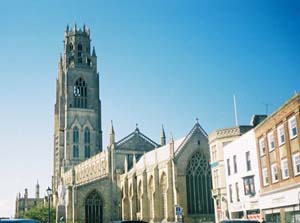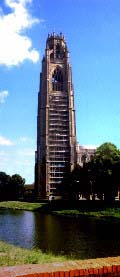Boston of the Fenlands and Its Stump
by Lisa Agnew
The original Boston, from whence the Pilgrim Fathers came and
where they were put on trial and eventually imprisoned for a year
or so, is located in the Lincolnshire Fens on the banks of the
River Witham. This Boston has a history that harks back to the
Dark Ages. Tradition has it that the settlement was founded in
654 AD by a Saxon monk named Botolph, who established a monastery
here. The word Boston is supposedly a contraction of
Botolph's Tun (tun being the Saxon word for town). Today,
the town can be seen from literally miles away, courtesy of the
Stump, or lantern tower, of St Botolph's church. At 83 meters high, it
can be seen across The Wash in Norfolk. Again it is tradition
that says that Boston Stump was built on woolpacks, possibly a
too literal interpretation of the underlying motivation for its
construction -- i.e. a surplus of riches brought to the area
courtesy of the mediaeval wool trade.
 There is
evidence of Danish incursion into Boston, yet there is no mention
of the settlement in the Doomsday Book of 1086. By the year 1125,
however, the town played host to an important annual fair, which
still takes place on the British Bank Holiday of May 1st. St
Botolph's Church was completed in 1470 and, in the 13th and 14th
centuries, no fewer than four orders of religious friars came to
establish themselves in the town, among them the notorious
Dominicans, chief instigators of the Continental Inquisition.
However, with Henry VIII's dissolution of the monasteries, all
four friaries were forcibly closed. There is
evidence of Danish incursion into Boston, yet there is no mention
of the settlement in the Doomsday Book of 1086. By the year 1125,
however, the town played host to an important annual fair, which
still takes place on the British Bank Holiday of May 1st. St
Botolph's Church was completed in 1470 and, in the 13th and 14th
centuries, no fewer than four orders of religious friars came to
establish themselves in the town, among them the notorious
Dominicans, chief instigators of the Continental Inquisition.
However, with Henry VIII's dissolution of the monasteries, all
four friaries were forcibly closed.
The Fenlands, with Boston situated at their northern limit, have
a distinctive aura. The land is exceedingly flat, a legacy of the
draining of the fens in the early 19th century. Before this great
reclamation of the land, Fenlanders were viewed as a people
apart, called 'slodgers' because they splashed through muddy
water, or 'yellow bellies', for a certain type of frog they were
said to resemble. [See reader note, below!] There were even rumors that they had webbed
feet! Regardless of this watery ancestry, the town of Boston
suffered devastation by fire, as did many other timber-built
mediaeval towns, on at least one occasion, in 1281.
St Botolph's Church is open every day except Sunday in summer and
on Wednesdays and Saturdays in winter and is the most spectacular
and well known of the town's attractions, with an architectural
style partly decorated and partly perpendicular. Those with
stamina can climb the Stump itself to get marvellous views of the
surrounding fenland but, as with any ancient staircase, one will
need to beware the unevenness of the steps' surface, a phenomena
caused by countless pairs of feet wearing at the stone; and the
sense of vertigo that accompanies a swift ascent up a tightly
winding flight of stairs. From the giddy heights and even at
ground level, visitors can still get a sense of the town's
mediaeval past, as the street layout has remained more or less
intact.
 The
old town is mostly situated on the east side of the River Witham,
which began to silt up during the 15th century, exacerbating a
general decline already felt by the town as the coveted wool
trade shifted away from the Midlands. The area has several
historic buildings which can still be viewed, in various states
of ruin, among them Hussey Tower, the remains of Hussey Hall, the
15th century house of Lord Hussey who, whilst a favorite of the
king's at one time, ultimately lost his head through earning
Henry VIII's disapproval over the Lincolnshire Rising affair.
Other historic sites include the Blackfriars Arts Center, which
is housed in the old Dominican brothers' refectory, and the
Grammar School, built in 1567 using masonry from the Franciscan
friary which occupied the site. The
old town is mostly situated on the east side of the River Witham,
which began to silt up during the 15th century, exacerbating a
general decline already felt by the town as the coveted wool
trade shifted away from the Midlands. The area has several
historic buildings which can still be viewed, in various states
of ruin, among them Hussey Tower, the remains of Hussey Hall, the
15th century house of Lord Hussey who, whilst a favorite of the
king's at one time, ultimately lost his head through earning
Henry VIII's disapproval over the Lincolnshire Rising affair.
Other historic sites include the Blackfriars Arts Center, which
is housed in the old Dominican brothers' refectory, and the
Grammar School, built in 1567 using masonry from the Franciscan
friary which occupied the site.
Boston's fortunes seesawed greatly during the reign of Henry
VIII, for it was he who gave the town its charter, in 1545. From
1552 onwards, Boston was graced with two sitting Members of
Parliament.
Boston lies about 5 miles inland from the north coast of The Wash
and some 100 miles north of London. Luton Airport is probably the
closest to Boston, but only just. If you are heading out of
London by vehicle, get on the A1 (M1 close to London) and stick
with the road as far as Grantham. Then take the A52 east until it
delivers you safely into Boston itself. Alternatively, there is a
train service to the town.
There is a plethora of fine B&Bs in this part of Britain.
Most are reasonably priced. Call at Tourist Information, Market
Place, phone: 01205 356656.
Reader Comment: Regarding the term "Yellowbellies"... The local Frog story is spurious to say the least - as this was a local phenomenon not seen outside the county.
Wikipedia gets a little closer but is still incorrect in its facts - The
stage coaches that operated in Lincolnshire in times past had yellow body
work. The livery for stage coaches from Lincoln was black but with yellow
undersides and front. They travelled to London and other major cities on a frequent basis and were known 'abroad' as Lincolnshire Yellowbellies.
- David Horry, whose website (http://www.horrywood.co.uk/) offers more information on Lincolnshire and artist/stamp collector Hedley Mobbs.
Related Articles:
- Winds of Change: Lincolnshire's Historic Windmills, by Mary Cook
- https://www.timetravel-britain.com/articles/country/windmills.shtml
More Information:
We regret that we no longer have the resources to maintain up-to-date links and/or hours and pricing details for the various sites and attractions listed on this website. For more information about the location(s) listed above, please use your favorite search engine or visit Wikipedia.
Lisa Agnew is a freelance writer of articles and speculative fiction. She is based in Auckland, New Zealand. English by birth, she harbours a life-long fascination with the history and folklore of her native land.
Article © 2006 Lisa Agnew
Photo #1 courtesy of Wikipedia.org; Photo #2 © Lisa Agnew
|
